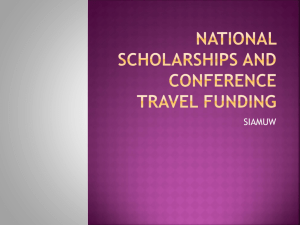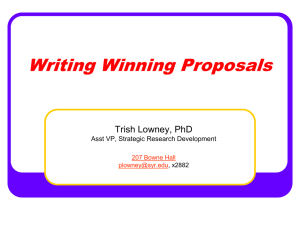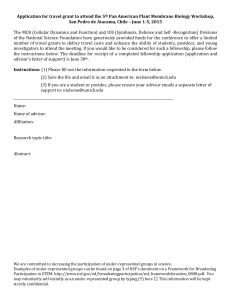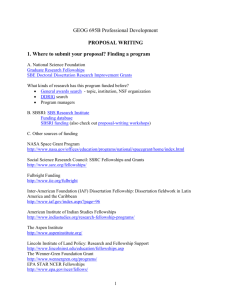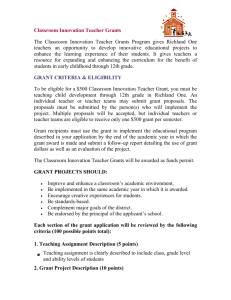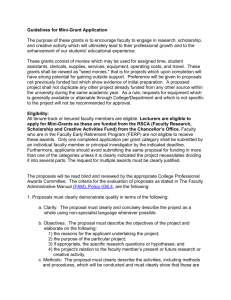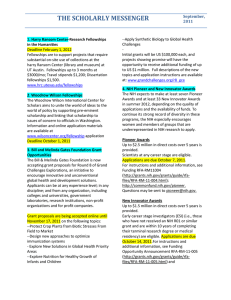Mary Lou Soffa, Barbara Ryder - Department of Computer Science
advertisement
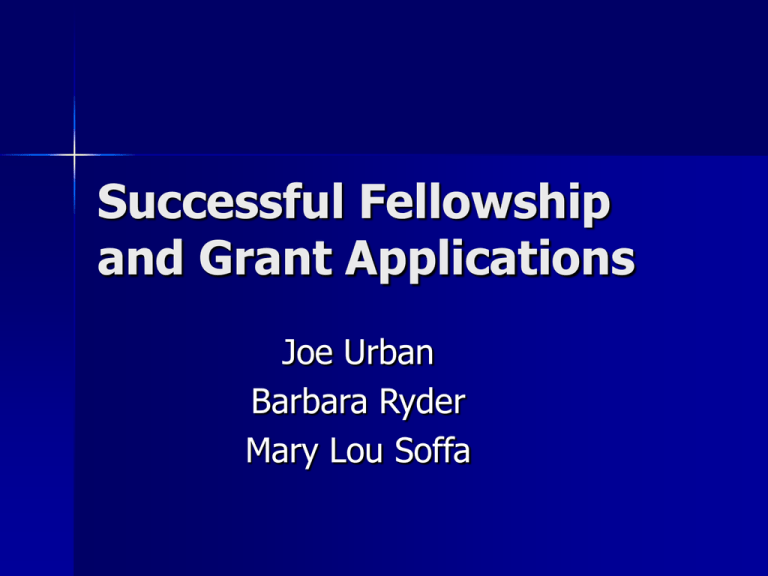
Successful Fellowship and Grant Applications Joe Urban Barbara Ryder Mary Lou Soffa Outline NSF – Joe Urban Grants – Barbara Ryder Fellowships - Mary Lou Soffa Successful Grant Applications Barbara G. Ryder Rutgers University Outline Grants - a ‘necessary evil’ Funding agencies – Government and Industry Evaluation process How to write a successful proposal? – Best practices – Proposal template – NSF CAREER proposals Sources to consult for more information Why obtain grant funding? To fund your research program Graduate students Equipment Summer salary Conference/workshop travel To enhance funding provided to your academic department and/or your research group To demonstrate the support of your peers for your research Research Funding - Govt NSF NIH, NASA, DOE, DHS Main source of funding for academic CS research Panels of peers review proposals in 1-2 day meetings in Washington, DC Serious funding difficulties lead to <10% success rate for research proposals Fit specific sub-areas of CS Compiling for parallel, grid computing, PL techniques for information-flow security DARPA and DoD agencies E.g., ONR, ASFOR Research Funding Industry Microsoft Research Faculty fellowship program http://research.microsoft.com/ur/us/nff/default.aspx External research & programs http://research.microsoft.com/ur/us/fundingopps/default.aspx Compilers, languages and runtimes http://research.microsoft.com/ur/us/progsys/default.aspx Research Funding Industry IBM - University programs Innovation awards (e.g., Eclipse Innovation Awards) Faculty awards Ph.D fellowships Shared university research (SUR) awards Open collaboration awards http://www-304.ibm.com/jct09002c/university/scholars/awards.html Evaluation Procedure NSF – Peer researchers receive ~10 proposals to read 3 weeks before panel meeting – Write reviews in NSF online system – Panel meets for 1-2 days in DC, discusses proposals and ranks them as competitive or not-competitive Panelists write panel summary comments for every proposal – NSF program managers make final choice of proposals to fund How to write a successful proposal? Be informed about major research program solicitation announcements Start early (2-3 months before the deadline) Obtain and study previously successful proposals written by colleagues Seek advice on how to present your ideas Give talks to colleagues/students for feedback on how best to explain ideas Have others read your proposal draft to discover unclear explanations or illogical flow of ideas Proposal Desirables A well-crafted proposal explains What is the motivating problem? How is it being addressed? What is new about the proposed approach? How will the new approach be designed and validated? What outcomes will be produced? – Research prototypes? Research papers? Ph.D students graduated? Algorithms embedded in commercial products? How will the work be accomplished? Proposal Template (NSF) Summary Tersely motivate problem of interest and give high-level view of your approach List proposed achievements of the research Must state intellectual merit and prospective broad impacts (e.g., educational, underrepresented groups) Proposal Template Introduction Motivate problem(s) being studied, with compelling argument for its importance and potential impact Background Existing concepts necessary to explain the research ideas Initial feasibility study with partial results on first steps of the research Proposal Template Research description Provide enough detail to show a coherent, multi-year investigation of an interesting Q, with multiple threads of inquiry Outline the proposed order of investigation of open questions; be frank about different possible paths that may be explored Tell how results will be validated (e.g., benchmarks, build prototype, proofs) Proposal Template Research plan Year by year concrete milestones to be accomplished by each person Emphasize the ‘fruits’ of the research –E.g., software prototypes to be built Related work Show your familiarity with the area Describe how your proposed work differs from existing approaches NSF CAREER Program Special program for junior faculty – $400K over 5 years – Can only apply 3 times to program – Higher success rates for funding Differences from ‘regular’ proposals Individual vision vs collaborative research Need to show can outline a major research investigation -- a career path Emphasis on researcher’s personal vision/impact Emphasis on supporting data (e.g., supporting letters from dept) Need to ask successful colleagues for example proposals CAREER Key Points Scope Neither too small or too large Sequence of ideas (each a paper’s worth) part of larger investigation Be able to show results already obtained on some Special thanks to Nasko Rountev CSE, Ohio State University CAREER - Key Points Vision Why is this problem important and of potential high impact to other researchers or computer professionals in general? How is this work different from previous work? CAREER - Key Points Be specific State insights that will lead to novel solutions Enumerate specific products that will have impact Explicit plan to accomplish goals Convince reader you will succeed Why are you right to solve these problems? CAREER - Key Points It’s about career advancement and leadership in computing Educational plans and real outreach activities matter NSF keen to integrate teaching and research, integrating research into the CS curriculum Impact to other scientific disciplines matter Already accomplished subgoals matter Other Kinds of Grants Travel grants for faculty Workshop support grants Broadening participation activities grants Educational (curriculum) grants CPATH program More Sources NSF Grant Proposal Writing Guide http://www.nsf.gov/publications/pub_summ.jsp?ods_key=gpg Interesting U Wisconsin Site: http://grants.library.wisc.edu/organizations/proposalwebsites.html Mike Ernst’s (MIT) advice on career proposal writing: http://pag.csail.mit.edu/~mernst/advice/careergrant.html Your university’s grants organization often runs grant preparation seminars and invites subscription to grant announcements Successful Fellowship Applications Mary Lou Soffa University of Virginia CRA-W Grad Student Cohort, March 2007 Finding Fellowship Opportunities Ask your advisor, peers – Fellowships in your area? – Fellowships at your university? Search! – Search engines – Scholarship websites (e.g. Fastweb.com, Scholarship.com) Fellowship Opportunities Government (DHS, NASA, NSF, …) Industrial (IBM, Microsoft, …) Foundations (Ford, Hertz, …) University (e.g., Mellon program at Pitt) Opportunities for Women (AT&T Labs, Google Anita Borg, … ) When and How Start looking early – Deadlines: often early (November to late February) Prioritize – Internship/monetary reward – Prestige – Amount of work required – Your commitment/promises Putting Together a Strong Application Positioning Yourself – Make yourself someone your department will want to “nominate” Don’t ignore your GPA, it can matter Publish, particularly as first-author Finish departmental milestones (prelims/quals, comprehensives, proposals…) Research Statement – Assume your readers are not familiar with your particular research area (or sometimes even with Computer Science)! Use clear, understandable, non-technical English Convince the reader why your research is important A Strong Application (continued) – Convey excitement / significance – Be both forward and backward looking How will the award help you complete your PhD (in ways that other alternatives wouldn’t)? How will the award build on what you’ve already done (and what are your past accomplishments)? – Be self-contained (don’t assume the reader will look at your webpage) A Strong Application (continued) Recommendation Letters – Ask someone who knows you professionally Curriculum Vitae – Do not “hide” or “pad” information – Make explicit Authorship order Publication quality (category types / acceptance rates) A Strong Application (continued) Other Advice – Have lots of people critique / proofread your materials your advisor, other faculty, fellow students, friends, even your family – Examine prior successful applications, if possible Example Fellowship Fellowship – NSF Graduate Research Fellowship Deadline – November 3 Terms – – – – Citizen of US No more than 1 year of grad school completed 3 years $30,000 per year, tuition, $10,500 tuition allowance, one-time $1000 international travel allowance Inside the Application General form Letters of reference Transcripts Essays – Personal history / personal statement – Past work – Proposed work – Something creative… Essays, Essays, Everywhere… ENTHUSIASM! – Why do you love your work? Helping others/other fields Advancing techniques/research Marriage of theory and practice – Why is your work important? – How will your work affect others? – What is the big idea? Do NOT get stuck in technical details Fellowship Pros and Cons Pros – Very prestigious – Often comes with summer position, travel money – Provides a lot of freedom Cons – Lots of work to track down – Lots of work to prepare – Extremely competitive to get – Maybe make you less serious about finding research topic Smaller Expenses Finding equipment/resources; – Ask department chair – Ask dean’s office Buying books – Book scholarships – TA discounts Finding Travel Money External travel funds Conference funds – Volunteer – Apply for a scholarship Ask professors, department chair, dean – Co-authors – Advisors Finding Travel Money External travel funds – Ex: http://women.acm.org/scholarships.html ACM SIGs Conferences – May include: Registration, hotel, meals, – Application Advisor information Submissions? Motivation (300 words or so) Summary Funding is important – Graduate student – Faculty member – Try to get experience in writing research applications – grants or fellowships Acknowledgment Diana Litman, University of Pittsburgh Grad Cohort, 2007
